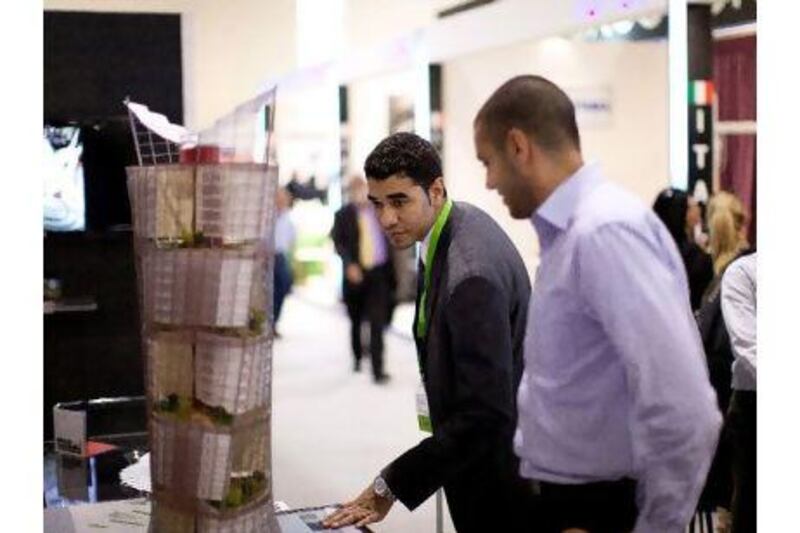DOHA // As a representative of a business that makes detailed scale models of luxury towers and giant infrastructure projects, Hisham Bou Habib makes a living out of chasing the world's economic booms.
This week, Mr Bou Habib was in Qatar. His company, Livescale, was one of 1,700 exhibitors clamouring for business at Project Qatar 2011, the country's largest annual construction exhibition.
"We follow the emerging real estate market - wherever there's a boom," said Mr Bou Habib, 25, a business development manager for the Beirut-based model maker. "It's obvious that a boom is coming here: They have the World Cup."
Livescale's models were sold for up to Dh27 million in Dubai before the property market tanked in 2008. Mr Bou Habib hopes to drum up equally lucrative contracts in Qatar, which is embarking on a massive investment drive as it prepares to host the world's largest sports tournament in 2022.
Yousuf Hussein Kamal, the minister of finance, said recently that Qatar will spend about US$140 billion (Dh514 billion) on developing its infrastructure over the next 11 years. The investment could boost an economy that is already one of the world's fastest growing. The International Monetary Fund estimated Qatar's gross domestic product grew by 16.3 per cent in 2010.
Laura Wojciechowski, an employee of TPG Publishing, a company that publishes several magazines about construction in the countries that are members of the Gulf Co-operation Council, said: "We used to circulate about 7,000 [Qatar Projects magazines], but it's probably gone up to 12,000 over the past six months."
In response to demand from 47 countries, the organisers increased the exhibition's floor space to 52,000 square metres - an increase of 73 per cent on the previous year. For four days, companies selling machines, materials and services to the construction industry networked in the exhibition's cavernous tents.
"Projects are already being announced. We expect a big demand for the next 12 years," said Yousuf al Mansouri, an engineer with Qatar Steel. He said his company is expanding to produce three million tonnes of steel per year by 2013 and "we might reach five million before the World Cup".
Qatar has already signed contracts for projects such as Festival City, a giant retail and entertainment complex valued at 6 billion Qatari riyals (Dh6.05bn), and the Lusail light rail transit system, part of a 30 billion riyal overhaul of the country's rail network.
Old buildings are being reduced to rubble in Doha's city centre to make space for developments such as new hotels.
The Qatar Tourism Authority said 41 hotels opened in 2010 and another 35 are scheduled to be completed this year. Tourists may soon be able to travel to Qatar over a causeway linking the peninsula to Bahrain.
A plan to build nine new stadiums and upgrade three others to host the tournament has a budget of $4 billion, and many companies at the exhibition were keen on getting the lucrative contracts that are expected to be handed out within the next couple of years.
"Stadiums are a huge investment. They can't make their money back out of sports-related activities," said Robert Else, the chairman and managing director of Terraplas, a manufacturer of turf and ice covers for stadiums.
He said stadiums need to host concerts to recoup some costs. He said he has already been involved in discussions with the government and contractors.
China, Germany, the UAE and Turkey were the largest foreign delegations at the exhibition. Yasemin Arslan, a foreign trade assistant for D-Cetinkaya, a Turkish manufacturer of machines that make concrete pipes, said her government is encouraging local businesses to do business in the Gulf by paying 50 per cent of their costs to travel to exhibitions.
"We have a lot of manufacturing in Turkey, but we don't have enough courage," Ms Arslan said.
With just five companies listed on the programme, it seems the United States will benefit from the construction boom less than Europe or Asia. Ryan Burke, the international business manager for Sport Court, a manufacturer of sports flooring based in Salt Lake City, said some US business might be working through partners and others are not keen on travelling to "the other side of the world".
Qatar has enough money to host such a major sporting event because it has the world's third largest gas reserves and is the top supplier of liquefied natural gas. But with just 300,000 locals among 1.5 million residents, the government could struggle to keep citizens happy as they make up an increasingly thin slice of the population.
"In the future you will be developing policies to ensure you are operating at a reasonable capacity," and it will involve more tourists, residents and workers, said Basma Abdelgafar, an assistant professor at the Qatar Foundation's Faculty of Islamic Studies.
"So far they've been successful in achieving some kind of balance, at least psychological balance, with what's happening. I haven't met many Qataris that are uncomfortable with the situation."
Ms Abdelgafar said Qatar is an open country and its investments in education, health care, science and technology, and tourism could benefit many other parts of the world. "When they're dedicating 2.8 per cent of GDP to research, it's close to $1.5 billion, it's huge."
"If you're investing in a global public good, I think that's a favour to the world. So when is it an oversupply? I don't think in this case you can get there," she said.





